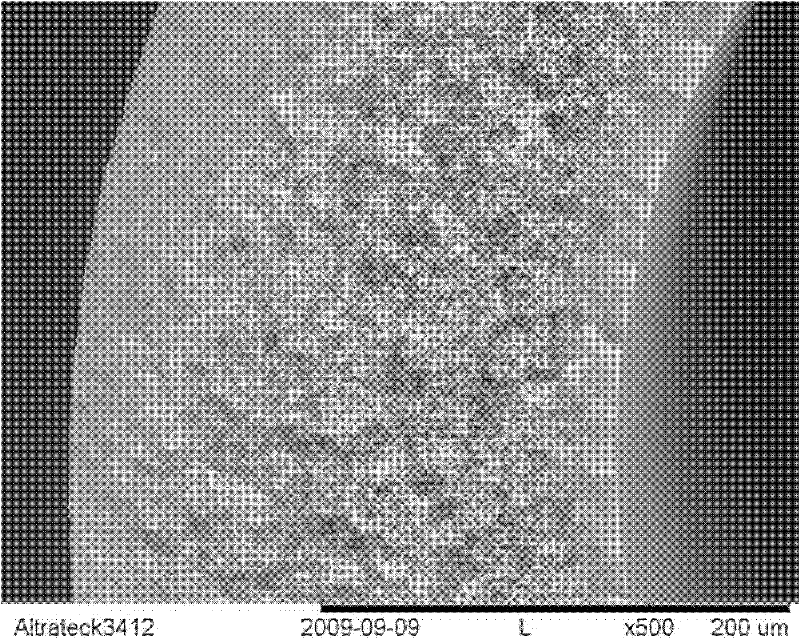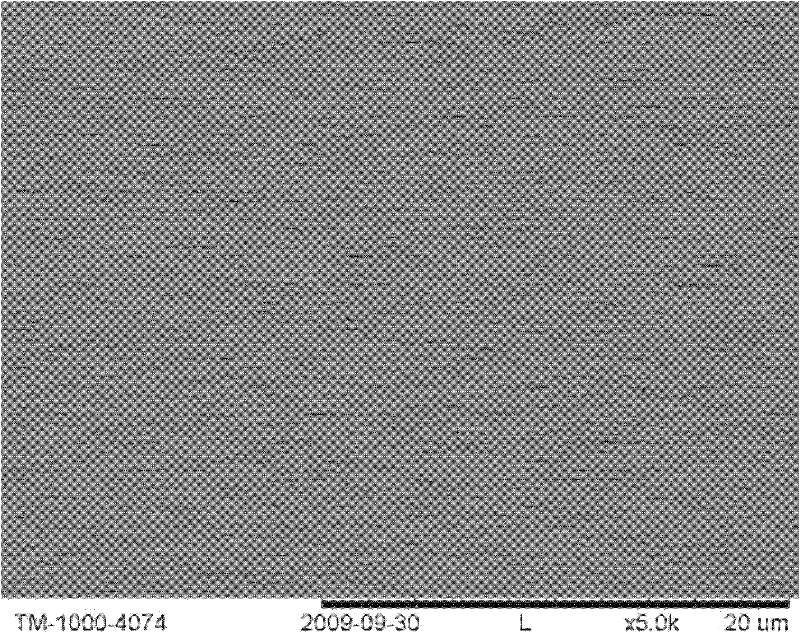Hydrophobically modified distillation membrane material of high throughout and high salt rejection rate and application thereof
A technology for hydrophobic modification and modification of materials, applied in the field of membrane materials, can solve problems such as low water flux, and achieve the effects of high stability, uniform modification process and high stability
- Summary
- Abstract
- Description
- Claims
- Application Information
AI Technical Summary
Problems solved by technology
Method used
Image
Examples
Embodiment 1
[0038] Put the asymmetric hydrophilic PES hollow fiber membrane (average pore size 50nm, contact angle 0°) in a 40°C oven to dry for 60min, then put the membrane into the plasma chamber, first use CF 4 (95%) and O 2 (5%) plasma cleans and etches the surface of the membrane to a rough surface, the processing power is 200w, the time is 20min, and the pressure in the chamber is 180mTorr to obtain the etched membrane surface. Then pass into CF 4 Gas, when the pressure in the chamber reaches 200mTorr, discharge to generate plasma, the power is 100w, the time is 5min, and the pressure in the chamber is 300mTorr. After modification, the contact angle of the outer surface of the film was 150°, and that of the inner surface was 100°. The modified membranes were loaded into components of a direct contact membrane distillation (DCMD) device for testing. The feed liquid is 4wt% NaCl aqueous solution, and the permeate is deionized water. When the feed liquid inlet temperature is 73.5°C...
Embodiment 2
[0040] As described in Example 1, the asymmetric hydrophilic PES hollow fiber membrane was dried in an oven at 50°C for 40 minutes. For 30min, the pressure in the chamber is 200mTorr, to obtain the activated membrane surface, and then pass into C 4 f 8 Gas, when the pressure in the chamber reaches 200mTorr, discharge to generate plasma, the power is 100w, the time is 10min, and the pressure in the chamber is 200mTorr. The contact angle of the outer surface of the modified film was 153°, and the contact angle of the inner surface was 102°. The modified membrane was used for vacuum membrane distillation test, the feed liquid was 4wt% NaCl aqueous solution, the vacuum degree was 0.05MPa, when the feed liquid inlet temperature was 74.1°C and the permeate side inlet temperature was 20.0°C, the flux was 78.8kg m -2 h -1 , the retention rate is 100%.
Embodiment 3
[0042] Put the asymmetric hydrophilic PES flat membrane (average pore size of 150 nm, contact angle of 0°) in an oven at 40°C for 60 min, put it into the plasma chamber after drying, and use O 2 The plasma will clean and activate the surface of the membrane. The processing power is 300w, the time is 10min, and the pressure in the chamber is 200mTorr. Take it out, put the membrane in 0.5mM OTS solution, react at 10°C for 24h, take out the membrane and dry it. The surface contact angle of the modified film was 136°, and the bottom surface contact angle was 130°. The modified membrane was subjected to the DCMD test as described in Example 1. When the feed liquid inlet temperature was 74.0°C and the permeate side inlet temperature was 19.0°C, the flux was 65.6kg m -2 h -1 , After running continuously for 10 hours, the flux did not decrease, and the rejection rate was 100%.
PUM
 Login to View More
Login to View More Abstract
Description
Claims
Application Information
 Login to View More
Login to View More - R&D
- Intellectual Property
- Life Sciences
- Materials
- Tech Scout
- Unparalleled Data Quality
- Higher Quality Content
- 60% Fewer Hallucinations
Browse by: Latest US Patents, China's latest patents, Technical Efficacy Thesaurus, Application Domain, Technology Topic, Popular Technical Reports.
© 2025 PatSnap. All rights reserved.Legal|Privacy policy|Modern Slavery Act Transparency Statement|Sitemap|About US| Contact US: help@patsnap.com



